SIMPLIS Tutorial
The objective of this tutorial is to create a Buck DC/DC Converter with
the following parameters:
- Switching Frequency = 500kHz
- Input Voltage = 12V
- Output Voltage = 1.2V
- Output Current = 10A
In this tutorial you will learn how to do the following:
- Create a schematic using the SIMetrix/SIMPLIS Schematic editor.
- Simulate your design using the three SIMPLIS analysis methods.
- Manipulate the output from the simulations.
1.0 Getting Started
In this Topic ShowHide
1.1 Downloading the Files
This tutorial follows the progression of a buck converter design from
first constructs to a final, parametrized, hierarchical design. Although
all schematics and supporting files can be downloaded from this file,
a stand-alone zip archive can be downloaded from the SIMPLIS Technologies
website.
- To download a zip file which includes the schematics and
a copy of this tutorial, click here.
- To download SIMetrix/SIMPLIS Intro,
the introductory version of SIMetrix/SIMPLIS, click here.
If you already have SIMPLIS on your computer, verify that you have
at least version 7.20
Note: The tutorial schematics were generated with
a small number of symbols in order to run on SIMetrix/SIMPLIS Intro.
SIMPLIS welcomes your feedback (positive, negative, bugs, etc.) to this
tutorial. To send comments, click here.
▲ back to top
1.2 Tips for Navigating this Tutorial
The SIMPLIS tutorial is intended to help new users get started with
the SIMPLIS simulator and to serve as a general reference to SIMPLIS.
If you are an experienced user, feel free to skip ahead to another section
using the links in the left panel.
1.2.1 Navigation Conventions
Topics with subsections include
a mini table of contents at the top of the page. Each subsection has a
back to top link at the end of the topic.
A
browse sequence is available with the left and right arrows at
the top of the left panel just below the Contents, Index, and Search buttons.
- The left arrow goes to the previous topic.
- The right arrow goes to the next topic.
Graphics with a blue border
have an enlarged view. The following tips explain how to open and close
the enlarged image:
- To open the graphic in a separate window so you can view it while
you follow the directions, right click on the graphic and select Open link in new window.
- To go to the expanded view from within the topic, click on the
graphic.
- To return to the text in your browser, click in the expanded graphic.
Note: In this tutorial, most of the screen shots
in the Schematic editor have the grid turned off for readability.
- The Hide grid
option is off by default. Leaving the grid visible as you work can
help you place items on the schematic.
- The View menu
in the Schematic editor has a Toggle
grid selection.
▲ back to top
1.2.2 Text Conventions
The following text conventions are designed to help you scan the content:
- Bold text usually indicates
something that you are to select on the screen or to type on the keyboard.
- File names appear in bold font.
- Green italic text indicates the
result that should occur after you complete the instructions in a
numbered step.
- Menu selections appear with a ▶ separating the menu items. For
example, File ▶ Save indicates
"From the menu bar, click File and then select Save."
▲ back to top
1.3 SIMetrix/SIMPLIS Environment
The SIMetrix/SIMPLIS software package comes with two simulators:
- The SIMetrix Simulator is an optimized SPICE simulator with
excellent convergence.
- The SIMPLIS Simulator, the one used in this tutorial, is
a Piecewise-Linear (PWL) simulator optimized for switching power supply
design.
SIMetrix/SIMPLIS has the following primary windows:
- Command shell is the window
that opens when you start the program. From the command shell, you
can open schematics, set options, run scripts, and perform other general
tasks.
- Schematic editor is the
tool you use to create your design.
- SIMPLIS Status shows the
progress of the current SIMPLIS simulation.
- Graph window appears after
you run a simulation.
- Symbol editor is the tool
you use to create or modify symbols.
▲ back to top
1.4 Setting General
Options
SIMPLIS comes with default options that affect various aspects of how
you work. For the purpose of this tutorial, you need to change the
simulator mode so that it will be correct when you create a new schematic.
You control all options through the Command Shell, which is the first
window that opens when you start up SIMPLIS.
To change the default simulator mode, follow these steps:
- Start up SIMetrix/SIMPLIS from the Start menu.
Result: The SIMetrix/SIMPLIS Command Shell
opens.
- In the Command Shell, click
File.
Result: The File menu appears.
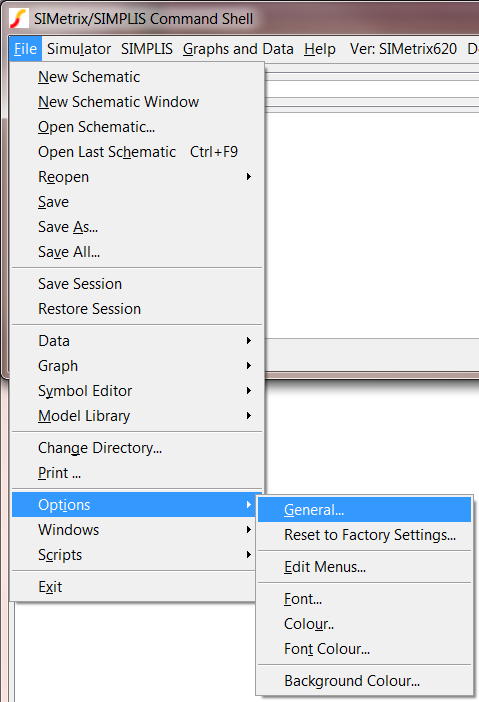
- Highlight Options and then
click General....
Result: The Options/Preferences dialog
box appears showing the Schematic tab.
- Go to the Initial Simulator
section in the lower-right corner, and click the SIMPLIS
radio button.
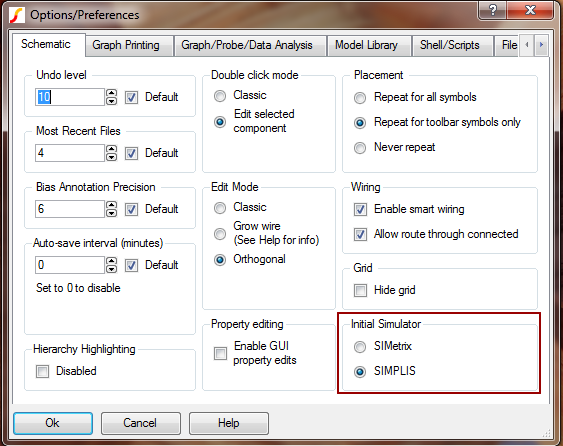
- Click Ok.
Result: These general options are saved
to your user profile and persist after you close SIMetrix/SIMPLIS.
These settings can be migrated to future versions of SIMetrix/SIMPLIS.
▲ back to top
1.5 Creating a New Schematic
To create a new schematic, follow these steps:
- In the Command Shell, click
File.
Result: The File menu appears.
- Click New Schematic.
Result: A new schematic opens.
- Check the lower right corner to verify that the mode is SIMPLIS.
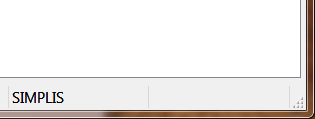
▲ back to top
1.6 Accessing the Parts Selector
The default view in the schematic editor hides the parts selector. Since
most of the symbols for this tutorial are in the parts selector, you need
to make it visible before you start placing symbols.
To access the parts selector, follow these steps:
- In the upper-right corner of the schematic editor, click Show Parts Selector.
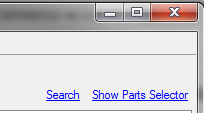
Result: The Parts Selector pane appears
on the right side of the editor.
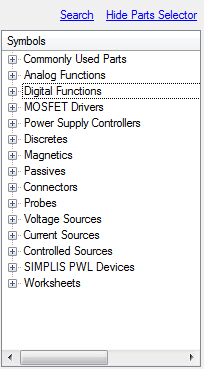
Click the + in front
of Commonly Used Parts.
Result: The list of symbols expands to
show most of the symbols that you need for this tutorial.
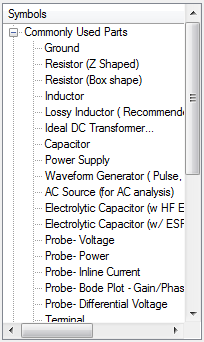
▲ back to top
1.7 Saving
your Schematic
At this point you have a blank schematic with the simulator mode set
to SIMPLIS. To save your schematic, follow these steps:
- Select File ▶ Save As.
- Navigate to a convenient location to use as a working directory
where you can save the schematics that you create in this tutorial.
- Name the file 0_my_buck_converter.sxsch.
▲ back to top
© 2015 simplistechnologies.com | All Rights Reserved





